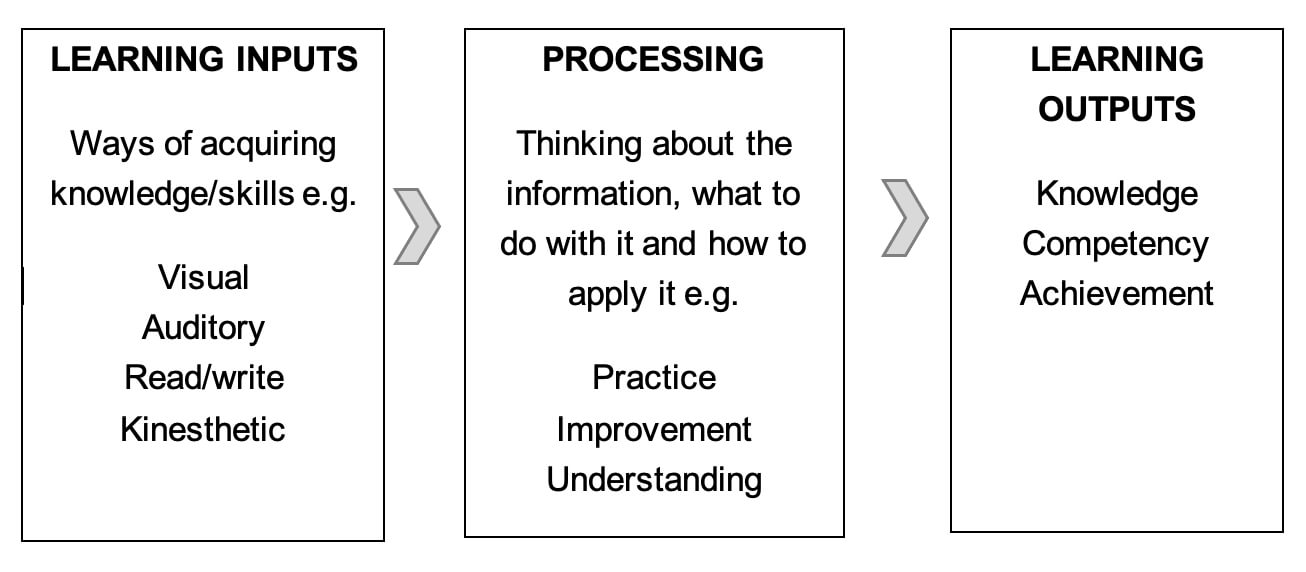In all walks of life, we are constantly learning new skills or more efficient ways of completing tasks. Have you ever wondered how this happens, why sometimes we learn new skills quicker than other skills, or learn at a different pace to other people? Everyone is unique and learns in their own way in their own time. Hopefully, this article will provide some insight into how learning happens, so that you and your driving instructor can work together so you can get the most out of your driving lessons.
There are many ways of acquiring knowledge or learning a new skill, eg. written reference material, pictures/diagrams, videos/presentations/demonstrations, collaborating in groups, hands-on learning etc. Although these are usually used in combination, there is likely to be one method that works best for you. This is most likely because you have a preferred learning style, I.E. you understand things best when you learn them in a particular way.
If you consider learning as a process, in its simplest form there are three steps involved in learning:

Our job as instructors is to provide you with the information you need in a way that makes sense to you. By adapting our teaching methods to suit your learning style, we can help you reach your learning goals as easily as possible.
There are many different ways of categorising learning styles, but Neil Fleming’s VARK model of learning styles is one of the most popular. According to the VARK model, learners are identified by whether they have a preference for Visual, Auditory, Read/Write or Kinaesthetic (hands-on) learning.
Visual learners learn best by seeing and would rather see information presented in a visual form rather than in written form. Graphic displays such as charts, diagrams, pictures/illustrations, handouts, and videos are all helpful learning tools for visual learners. You are likely to be a visual learner if visualising information in your mind helps you remember it better, and if you have to see information in order to remember it.
Auditory (or aural) learners learn best by hearing information and are good at remembering things they are told, so verbal teaching and discussion tend to be most helpful to them. You are likely to be an auditory learner if reading out loud helps you remember information better, or if you prefer to listen to information rather than read it.
Reading and writing learners prefer to take in information that is displayed as words and text and find it helpful to write down information in order to help you learn and remember it. You are likely to be a reading and writing learner if you like to read information, take notes, make lists and like handouts/presentations.
Kinaesthetic learners learn best by touching and doing, moving and experimenting, so practical, hands-on experience is important for kinaesthetic learners. You are likely to be a kinaesthetic learner if you are good at activities such as painting, cooking, mechanics, sports, and woodworking, you enjoy performing tasks that involve directly manipulating objects and materials, and if you have to practice doing something in order to learn it.
Have you identified which learning style you prefer? You may have a combination of learning styles, but usually you will have one which is dominant. Understanding your own learning preferences can be helpful because if you know which learning style appeals to you most, using the associated study strategies in conjunction with other learning methods might help you remember things better, and can also help your instructor to understand the best ways to help you learn.
If you want to find out your learning style, why not complete the following VARK questionnaire.
When you are being taught to drive, your instructor may or may not have the same preferred learning style as you. Instructors may naturally teach according to their learning style, for example, your instructor might focus on discussions and questions because their dominant learning style is auditory. However, if you are a visual learner this might not work best for you, as you may be a visual learner and need to see pictures and diagrams to support the topic being discussed. The expectation is that the instructor will adapt their teaching method based on your learning style needs. This is referred to as “client-centred learning” in the driving instruction industry. Therefore, if you are finding it difficult to learn in a certain way, don’t be afraid to speak up and let your instructor know so that you can work together to make your learning work for you. Instructors may be able to use various teaching tools eg. lesson planners with words and pictures, different questions, interactive apps on mobile devices, demonstrating, dash cam footage etc.
Don’t forget, instructors are here to help you in every way they can so that you become a successful driver. An understanding of your learning style can benefit you and your instructor in working together to achieve this goal.
Written by Anthony Johnson
Grade A - 51/51
ORDIT Registered Trainer






